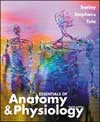 |  Essentials of Anatomy & Physiology, 4/e Rod R. Seeley,
Idaho State University
Philip Tate,
Phoenix College
Trent D. Stephens,
Idaho State University
The Muscular System
Study OutlineFunctions of the Muscular System
Body movement
Maintenance of posture
Respiration
Production of body heat
Communication
Constriction of organs and vessels
Heart beat
Characteristics of Skeletal Muscle
Contractility
Excitability
Extensibility
Elasticity
Muscle Structure(Fig. 7.2, p. 155)Muscle
Muscle fasciculi
Muscle fibers (cells)Myofibrils Systems Pathology: Muscular Dystrophy, p. 189
Sarcomeres(Fig. 7.3, p. 156)Actin and myosin myofilaments
Membrane Potentials
Resting membrane potential(Fig. 7.4a, b, p. 157)Depolarization
Repolarization
Action potential(Fig. 7.4c, d, p. 157) Nerve supply(Fig. 7.5, p. 158)Neuromuscular junctions (synapses)(Fig. 7.6, p. 159)Neurotransmitter-acetylcholine
Acetylcholinesterase
Muscle Contraction(Table 7.1, p. 160)Sliding filament mechanism(Fig. 7.7, p. 161)Calcium ions
Role of ATP(Fig. 7.8, p. 162)Cross bridge formation
Relaxation
Muscle twitch, tetanus, and recruitment(Fig. 7.9, Fig. 7.10 p. 163)Energy requirements for muscle contraction(Fig. 7.11, p. 164)Creatine phosphate
Anaerobic respiration
ATP
Lactic acid
Aerobic respiration
ATP
CO2 and H2O
Muscle fatigue and physiological contractureClinical Focus: Disorders
and Other Conditions of Muscle Tissue, p. 166
Types of muscle contraction
Isotonic contractions
Isometric contractions
Concentric contractions
Eccentric contractions
Muscle tone
Muscle fiber types
Fast-twitch fibers
Slow-twitch fibers
Smooth Muscle and Cardiac Muscle
Characteristics(Table 7.2, p. 167) Skeletal Muscle Anatomy(Fig, 7.1, p. 153)General Principles and Terminology(Fig. 7.12, p. 167)Origin and insertion
Synergists and antagonists
Prime movers and fixators
Nomenclature
Superficial muscles (Fig. 7.13a. b., p. 168-169)
(Fig. 7-14, p. 170 surface view) Head muscles
Muscles of facial expression(Table 7.3, Fig. 7.15, p. 170-171)Muscles of mastication(Table 7.4, Fig. 7.15, p. 171)Tongue and swallowing muscles(Fig. 7.16, Table 7.5, p. 172) Neck muscles(Tbl. 7.6, p. 173; Fig. 7.13, p169, Fig. 7.15, p. 171,
Fig. 7.17, p. 173, Fig. 7.21, p.128)Trunk muscles
Muscles moving vertebral column(Fig. 7.17, Table 7.7, p. 173-74)Thoracic muscles(Fig. 7.18, Table 7.8, p. 175; Fig. 7.21, p. 178)Abdominal wall muscles(Fig. 7.19, Table 7.9, p. 176)Pelvic floor and perineal muscles(Fig. 7.20, Table 7.10, p. 177) Upper limb muscles(Fig. 7.24, p. 182 - surface view)Scapular movements(Tbl. 7.11, Fig. 7.22, p. 179-80)Arm muscles and movements(Table 7.12, 7.13, p. 181; Fig. 7.21, p.
178; Fig. 7.22, p. 180)Forearm muscles(Fig. 7.23, Table 7.14, p. 182-183)Wrist and finger movements
Lower limb muscles(Fig. 7.27, p. 188 - surface view)Thigh movements(Tbl. 7.15, Fig. 7.25, p. 184-85)Leg movements(Fig. 7.25, Table 7.16, p. 185-86)Ankle and toe movements(Fig. 7.26, Table 7.17, p. 187) |
|



 2002 McGraw-Hill Higher Education
2002 McGraw-Hill Higher Education